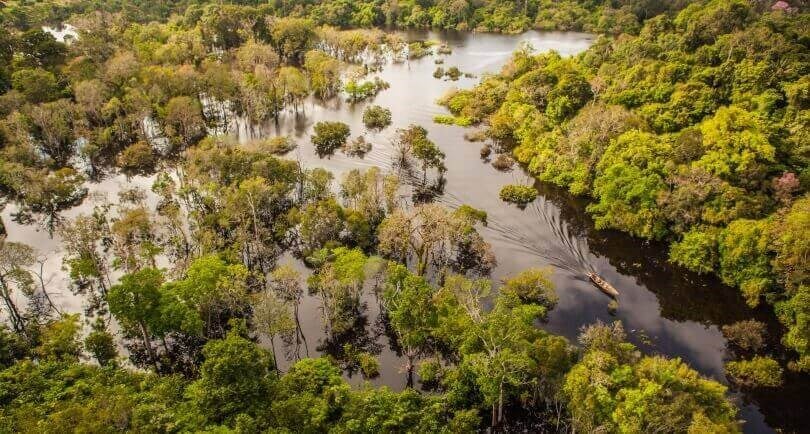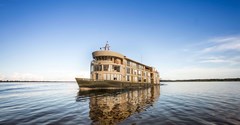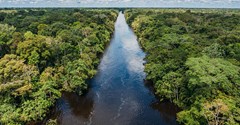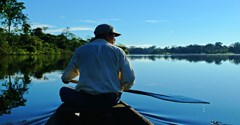Learn more about which factors could most determine when you time your visit to the Amazon Rainforest.
Amazon Climate
The Amazon's climate does not actually vary too dramatically from month-to-month. Generally speaking, the humidity and temperature remain high all year (typically between 23 to 32 degrees), though cold spells can sweep up unexpectedly from Antarctica and can last for a couple of days. There is also not a huge distinction between the wet and dry seasons, with downpours liable during most of the year. Therefore the two factors that will probably most determine when to visit the Amazon are the water levels, which do vary dramatically before and after the rainy season and glacial melt in the Andes (from where the river originates) and secondly, when are the best times of the year to visit (or avoid) some of the places you might want to combine with the Amazon in Brazil, Peru or Ecuador.
Rise and fall of water levels
River levels tend to rise between January and April, reaching their peak around April, May and June. They then begin to recede, reaching their lowest levels between September and October.
The period following the wet season (April to June) is a great time to experience the flooded forests around Manaus in Brazil and on a cruise from Iquitos in Peru. The water buries the forest floor, by as much as up to 12-15 metres in some cases, allowing you to get much closer to the canopies and the wildlife which resides in the treetops. One way to explore these unique landscapes is in a canoe, moving through a maze of tree trunks, lianas and undergrowth and seeing the branches of the tree coming right down to the water. The downside to visiting at this time of the year is that aquatic animals, including caimans, fishes and river dolphins, become dispersed and much harder to see. Additionally some trails are rendered inaccessible. March is a particularly good time to see the remarkable flora of the Amazon coming into full bloom.
The low water period, (September to October) is conversely the ideal time to see the likes of caiman and dolphin in the now shallower waterways of this part of the Amazon. The flip-side is that tree-based animals are once again dispersed and so much harder to spot.
 Flooded forest near Manaus (by Visit Brasil)
Flooded forest near Manaus (by Visit Brasil)
Lodges of Peru and Ecuador
The lodges in the Tambopata region of the Peruvian Amazon and the Yasuni region in Ecuador are not subject to such extreme flooding and so there is less of a distinction between the different times of the year. The lodges in Ecuador are very close to the equator and so there is even less of a difference between the seasons.
Most visitors prefer the dry season between May and October (or November to December at the Kapawi Lodge in Ecuador). This is when paths are clearer and easier to walk on and macaws and parrots are more abundant at the many clicks near the lodges. During the rainy season, areas of wetland are flooded and lakes are healthier, offering more opportunities to see aquatic animals. Most lodges also tend to be a little quieter during this part of the year.
Considering the other half of your holiday
As previously mentioned, another consideration might be when is the best time to visit the other places you want to combine with the Amazon. Fortunately most places are great all-year destinations, with a few minor exceptions.
Given its proximity to the equator, Quito in Ecuador enjoys a fairly stable climate and can be comfortably visited in any month. The Galapagos Islands undergo a yearly cycle of nature, with particular highlights throughout the year, but with the guarantee of a memorable experience during nearly every month of the year. The main exception to this is September, when seas become choppier.
Rio de Janeiro can be visited all year, remembering that the seasons are the other way round to ours. Unless you want to experience the Rio Carnival alongside a visit to the Amazon, it is best to avoid February, when the city comes to a standstill. Brazil's second biggest celebrations are the June Festivals, which take place throughout the north of the country and could make an interesting option to combine with the Amazon. Wildlife enthusiasts might consider visiting the Pantanal, whose open wetlands stand in contrast to the dense jungle of the Amazon and promise greater wildlife opportunities. Its most prized sighting is the elusive jaguar, most visible between July and November, along with giant river otters.
Peru is also a great all-year destination, particularly the Inca heartland around Cusco, Machu Picchu, the Sacred Valley and Lake Titicaca. Some important considerations are that rain at Machu Picchu is generally heaviest during January and February, meaning fewer crowds but less than ideal conditions, whereas June to August are the busiest months. The Inca Trail closes for maintenance in February.
Summary
As you can see, many factors go into deciding when to visit the Amazon, with different parts of the year offering different advantages and disadvantages. Some of the key questions are whether you specifically want to see either tree-based or aquatic animals (remembering that the size and density of the Amazon makes both endeavours difficult regardless of the season) or whether you are particularly keen to experience the flooded forests. With a couple of notable exceptions though, the Amazon and indeed much of South America are great destinations to visit throughout the year. We'd be delighted to talk through your options to help create the ideal itinerary to make the most of your trip to the Amazon Rainforest. Just drop us an email or give us a call!
Choose your perfect holiday
Find inspiration from our selection of itinerary suggestions, a great starting point for your next trip
View More Tours
Stay in touch
Infuse your travels, with inspiration from our monthly newsletter.
READY - 20 April 2024
LANDMARK TOURS: Multi-Country & Cross Continent. New Cosmopolitan Tour: Buenos Aires, Iguazu, Rio
CHINA & INDIA: Local Life, People & Unique Cultures
GUIDES by Veloso Tours, are the best Local Hosts
PRIVATE VILLAS: Quality Time in exclusive settings
TRAVEL INSURANCE with extensive COVID-19 cover








